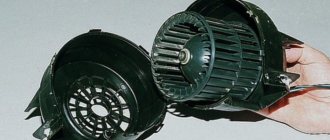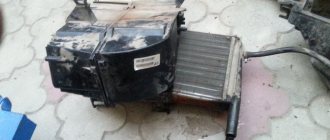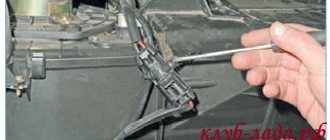Purpose and principle of operation of the VAZ-2107 heater radiator
The source of heat in the heating system of the VAZ-2107 car is the liquid with which the cooling system is filled. The cooling system is designed in such a way that the heater radiator is part of its overall circuit. The principle of operation of the radiator is that air flows, penetrating into the car through the air intake on the hood, enter the heating compartment, where they are heated by the heater radiator and move further through the air ducts into the passenger compartment.
The VAZ-2107 heater radiator is a key element of the vehicle heating system
The degree of heating of the air directed into the car interior depends on the temperature of the coolant and the position of the heater valve damper. You can adjust the position of the faucet using the upper slider of the heating system control mechanism: the extreme left position of the slider means that the faucet is closed and the stove is not working, the extreme right position means the faucet is fully open.
The position of the tap can be adjusted using the upper slider of the heating system control mechanism
Initially, the heater radiators of the VAZ-2107 (and other “classic” models) were made exclusively of copper. Currently, many car owners, in order to save money, install aluminum heater radiators, which, although they are cheaper than copper ones, have worse heat transfer rates. The aluminum radiator does not always cope with the large flow of frosty air entering the air intake when driving on the highway, and in this case the interior does not warm up enough.
The heater radiator can be two or three rows . The heat exchanger has a horizontal position and is housed in a special plastic housing. The radiator is attached to the body with two self-tapping screws, the tap is mounted in the supply pipe. Structurally, the radiator consists of:
- systems of tubes located in honeycomb ribs that improve heat transfer;
- inlet and return tanks;
- inlet and outlet pipes.
Video: recommendations for choosing a VAZ-2107 heater radiator
The cross-section of the tubes can be round or square . Round tubes are easier to manufacture, but the heat transfer of such products is lower than that of square ones, so so-called turbulators are placed inside the round tubes - spiral-shaped plastic strips that help increase heat transfer rates due to turbulence and mixing of the refrigerant. In flat tubes, turbulence is created due to their shape, so additional elements are not required.
The dimensions of the three-row copper radiator SHAAZ are:
- length - 254 mm;
- width - 67 mm;
- height - 184 mm.
Product weight - 2.2 kg.
A double-row aluminum radiator may have other dimensions.
What is a car heater radiator
Almost every car is equipped with an interior heating system, in which one of the main elements is the radiator. Thanks to this part, heat is collected from the coolant and subsequently supplied to the passenger compartment.
Where is the heater radiator installed on the VAZ 2104–2107 and what functions does it perform?
The heater radiator on all classic Zhiguli cars is located in a special box under the front panel. The product is a heat exchanger, the main function of which is to transfer heat from the coolant (antifreeze) with subsequent distribution throughout the cabin. This unit works in the same way as the main radiator of the power unit. For the stove to function correctly, the heat exchanger must be constantly heated. This is achieved by connecting the radiator to the engine cooling system using tubes and rubber pipes and constant circulation of liquid through a water pump (pump).
The heater radiator on the “classic” is located in a special box under the front panel
Stove radiator design
The heat exchanger consists of two tanks and copper or aluminum honeycombs. The tanks are connected by soldering or sealant, depending on the material of the part. The main components of the stove, in addition to the radiator, are the fan and the control unit, which consists of levers and cables.
1 - additional motor speed resistor; 2 — fan casing; 3 — fan guide casing; 4 — spring holders of the lower housing; 5 — radiator housing; 6 — air supply cover; 7 — radiator gasket; 8 — stove radiator; 9 — coolant pipes; 10 — heater valve; 11 — impeller of the heater electric motor; 12 — electric heater motor; 13 — spring latch of the heater motor; 14 — pillow of the heater motor; 15 — flap of the side air inlets; 16 — lower cover (damper) of the heater, airflow for the feet
Air from outside passes through the hole in the hood and enters the plastic air intake casing located in the engine compartment under the windshield. The air flow then enters the heat exchanger, which is heated by the coolant. When the car is idle or driving at low speed, the heater fan is turned on in the cabin, which drives cold air through the radiator, thereby heating it and supplying it to the cabin.
The heater radiator consists of tanks and honeycombs through which coolant circulates
When the car is moving at high speed, the fan does not need to be turned on, since the oncoming flow creates sufficient pressure to pump warm air. The more the coolant heats up, the more heat the radiator gives off. The level of liquid entering the heat exchanger is regulated by a tap. Therefore, if there is a need to change the temperature in the cabin, for example, to make the air less hot, the tap is closed partially or completely using a flexible rod and lever.
Controlling the stove is quite simple. There are several handles on the central panel:
- the top one is designed to adjust the position of the stove tap (to the left - the tap is closed, to the right - open);
- the middle handle changes the position of the air supply cover, thereby changing the intensity of the warm air supply;
- The lower lever allows you to adjust the damper of the heated glass air ducts (position to the right - the air flow goes to the side windows, to the left - to the windshield).
The heater in the cabin is controlled using three levers that can be moved horizontally
How to choose the best heater radiator for VAZ-2107
To optimize the operation of the stove, VAZ-2107 owners quite often replace the standard radiator with a heat exchanger from another domestic model or a foreign car.
Radiators of other VAZ models
An alternative to the factory radiator of the VAZ-2107 stove can be a similar product from the “five”. In general, for the “classics” there are two types of stove radiators - VAZ-2101 and VAZ-2105. Of course, the seventh model is suitable for a “five” heat exchanger. The standard size of a standard radiator from a “kopek” is 185x215x62 mm, from a “five” - 195x215x50 mm, i.e. the product from a VAZ-2101 will not fit into the plastic casing of a “seven” due to its thickness.
Read about the design of the VAZ 2105: https://bumper.guru/klassicheskie-modeli-vaz/poleznoe/vaz-2105-inzhektor.html
Video: which stove radiator is suitable for the “seven”
If the car owner decides to replace the entire stove, then the most acceptable option is a heater from a VAZ-2108.
From a foreign car
Instead of the “native” heater radiator on the VAZ-2107, you can install a “foreign” one, if it fits in size. Practice has shown that a copper heat exchanger from Mitsubishi turned out to be quite suitable for installation in the “seven”.
I had several classic VAZs, and different radiators in the stoves and in the cooling system. Based on operating experience, I can say one thing: the heat transfer is almost the same due to the metal tanks and an additional row of cassettes; it is almost not inferior in heat transfer to an aluminum radiator. But aluminum weighs less and is practically not subject to thermal expansion. Yes, its heat dissipation is better; when you open the heater tap, brass produces heat in almost a minute, and aluminum in a couple of seconds. The only negative is the strength, but in our country everyone is trying not to attract masters, but to do something themselves with crooked hands using a crowbar and a sledgehammer. And aluminum is a delicate metal, you need to be gentle with it, and then everything will be fine. And many say that the pressure in the cooling system is vomiting them. So, if you monitor the valves of the expansion caps and the cooling radiator, then there will be no excess pressure.
Madzh
https://otzovik.com/review_2636026.html
How to replace a fan with a more powerful one (in detail)
Work order:
- Remove the lower part of the stove - the casing on which a regular fan is mounted.
- Remove the standard electric fan completely as it will no longer be needed.
- Carefully cut off one of the aerodynamic ridges that supply air to the legs of the passenger and driver, since the motor from the V8 is much longer.
- Next, the impeller is removed, and all functions fall on a standard five-bladed fan.
- The hole in the impeller needs to be slightly enlarged in diameter and the new shaft carefully inserted into it. Make sure that the new structure fits securely into place.
- Before installing a new fan, connect it directly and check its functionality.
- Replace the built-in resistor, the main task of which is to ensure relatively quiet operation of the fan. As a result of the large volume of air being transferred, the new fan will create a lot of noise. The best replacement option would be a resistor installed on the figure eight.
- Replace the fan switch with a similar one from model 2108. The reason is that when the heater operates for a long time, a completely different current will be supplied, which is why after some time the standard power button will simply melt.
Stove malfunctions
Due to the simple design, there are not so many faults in the interior heating system of the VAZ-2107. They are divided into mechanical and electrical. Mechanical problems include:
- jamming of the antifreeze supply valve;
- radiator clogged;
- breaks in the drive mechanism cables;
- smudges.
The tap and heater radiator are the “weak” points in the VAZ-2107 stove. If in winter the tap works frequently, then with the onset of summer it turns off and remains in that position. Because of this, it jams, and when winter comes, attempts to open it lead to a break in the control cable.
Video: The heater on the classic VAZ 2101-07 does not work. We are looking for the reason.
It is difficult to “move” a faucet that is stuck in one position, so it is easier to replace the faulty unit. And cutting off the antifreeze supply also affects the radiator. The absence of fluid movement for a long period (when operating a car in the summer, when the stove is not in use) leads to intensive formation of oxides inside the radiator, which clog the heat exchanger pipelines. Because of this, the throughput of the radiator decreases, and with it the performance of the stove.
A clogged heater radiator is washed, but if there are a lot of deposits, then they can only be removed mechanically, and for this the radiator is unsoldered. Soldering it back is difficult and sometimes it is easier to replace the heat exchanger than to wash it.
Leaks are also a common failure. They occur at the junction of the pipes, and also if a crack appears in the radiator. In the first case, the leak is eliminated by tightening the fastening clamps, in the second - by soldering or replacing the radiator.
Electrical faults include burnout of the electric motor, open circuit of its power supply and breakdown of the control key.











